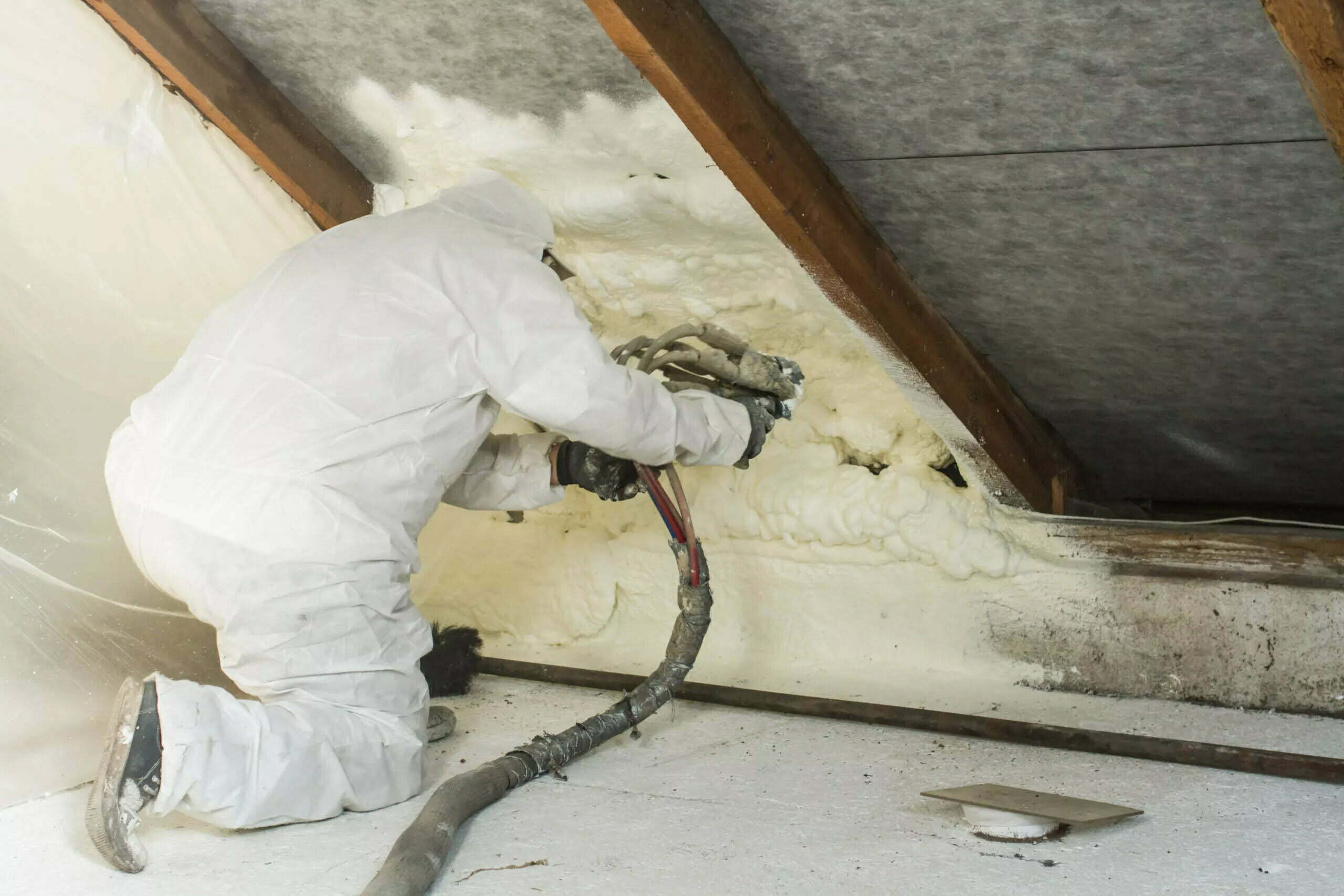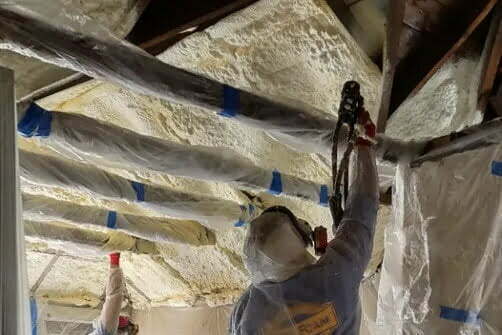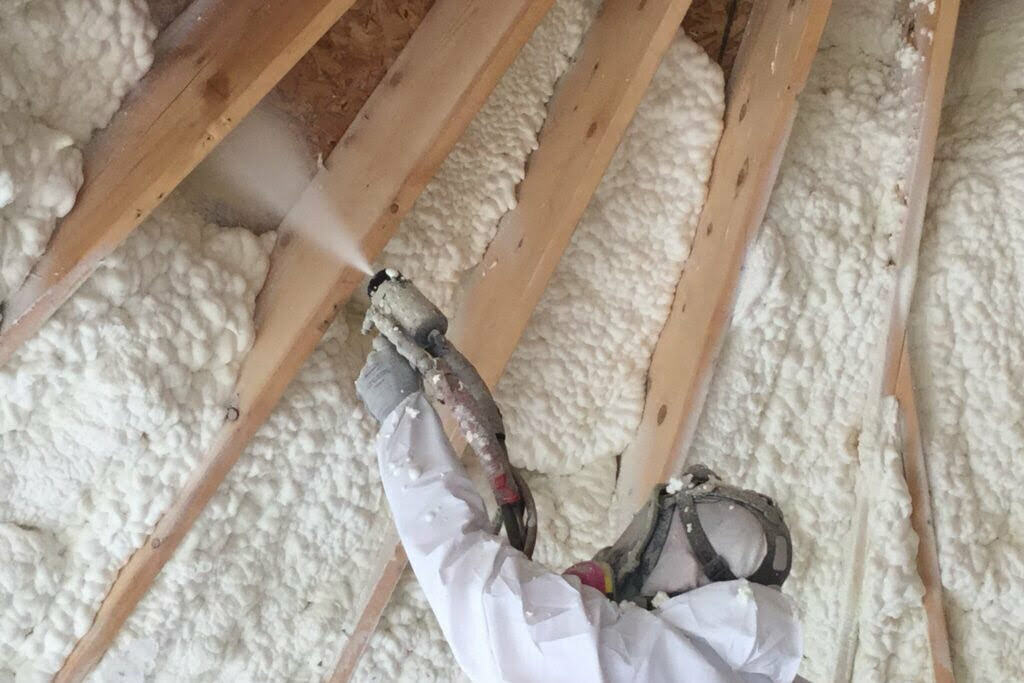Spray polyurethane foam (SPF) insulation is a highly effective and versatile insulating material for buildings. Learning proper spray foam application techniques allows homeowners and contractors to leverage its benefits for insulation projects.
This comprehensive guide covers spray foam fundamentals, equipment needs, application steps, best practices, and long-term care to help inform you about spray foam insulation application. We’ll also show you why hiring professionals is even better.
Understanding the Basics of Spray Foam Insulation
Before jumping into full details on application methods, tools, and best practices, it’s helpful to review some core spray foam insulation essentials. Grasping these basics allows for a better understanding of installation procedures.
The Importance and Benefits of Foam Insulation
Polyurethane spray foam insulation offers several key advantages compared to traditional fiberglass batts:
- Significantly higher R-value insulation per inch, providing more thermal resistance in a thinner layer
- Ability to fill cracks, gaps, and voids thoroughly, sealing air spaces that allow costly energy loss
- Rigid foam structure that does not sag or settle over time like fiberglass, maintaining insulation value
- Capacity to adhere to any shape of surface configuration, enabling insulation of irregular areas
- Resistance to absorbing moisture, growing mold, and nesting pests when installed correctly
- Enhanced structural integrity and shear strength when applied properly on roof decks and wall assemblies
These unique characteristics make polyurethane spray foam highly effective for insulation, air sealing, moisture and pest control, and structural enhancement.
Types of Spray Foam Insulation: Open-Cell vs Closed-Cell
There are two main kinds of spray polyurethane foam insulation: open-cell and closed-cell. Understanding the differences in their properties and performance helps determine optimal application.
- Open-cell foam has a spongy, fleshy texture due to its composition of small open-air pockets. It offers an R-value of approximately R-3 to R-4 per inch.
- Closed-cell foam has a denser feel given its structure of microscopic plastic cell walls. It delivers a higher R-value around R-6 to R-7.4 per inch.
- Closed-cell SPF provides higher insulation value per inch along with enhanced moisture resistance. Open-cell foam works well for interior wall insulation applications.
With the fundamentals covered, we can now dive into proper installation methods.
Essential Equipment and Materials for Spray Foam Insulation
Applying spray foam properly requires having the right application tools and protective gear. Installing foam insulation is a tricky job and is best left to experienced professionals like the team at Cincinnati RetroFoam. But if you’re determined to install spray foam insulation yourself, be sure that you have the proper equipment and materials.
Spray Foam Insulation Kits
Specialized spray foam rigs are needed to correctly mix and disperse the liquid components:
- Foam spray gun with heaters to maintain chemical temperature
- High-pressure hoses to transfer components
- Proportioner to mix the two parts at the right ratio
Kits allow controlled dispensing for professional-quality foam application.
Personal Protective Equipment (PPE) Needed for Spray Foam Insulation
Safe chemical handling also requires proper PPE:
- Full-body protective coveralls
- Rubber gloves resistant to foam chemicals
- Respirator mask or supplied air system
- Safety goggles to protect eyes
- Head covering to avoid foam on hair and skin
Never spray foam without complete protective gear.
Preparing Your Workspace
Choose an application area with ample ventilation and clearance. Cover any surfaces not being foamed to protect them from overspray.
Stage all tools and PPE nearby for an organized spray foam session.
Step-by-Step Guide on How to Apply Spray Foam Insulation
Follow these key steps to apply spray foam insulation correctly:
Planning and Evaluating Your Insulation Needs
- Determine the required R-value for space and recommended foam thickness
- Calculate square footage to buy enough foam material
- Ensure foam chemistries match needs (open-cell or closed-cell)
Setting Up and Using the Foam Gun
- Connect hoses securely and test spray to calibrate foam output
- Adjust pressure and temperature for ideal foam consistency
- Keep gun perpendicular to surface at 6-12 inches distance
Applying the Foam Insulation
- Spray in layers up to the recommended thickness
- Allow 10 minutes between passes for the foam to partially cure
- Ensure adequate coverage without gaps or runs
- Watch for changes in foam texture indicating low chemical
Post-Application: Curing Process and Cleanup
- Give foam at least 1 hour to fully cure and solidify
- Ventilate the area thoroughly after application
- Clean equipment and surfaces with acetone or polyurethane cleaner
- Discard used PPE carefully
Proper application technique results in high-quality spray foam insulation.
Safety Measures and Best Practices for Spray Foam Insulation
While extremely useful, polyurethane spray foam chemicals demand caution. Following best practices during and after installation is critical.
Health and Safety Considerations When Applying Spray Foam
- Always wear full personal protective equipment (PPE), including respirators, gloves, and suits, whenever spraying foam or working around uncured foam. Keep PPE on until the foam has fully cured and the fumes have ventilated.
- Eliminate any sources of ignition before spraying and while foam cures, as the vapors are extremely flammable. Avoid light switches, flames, sparks, or operating equipment in the vicinity.
- Monitor skin underneath gloves and suits regularly for rashes or reactions to the foam chemicals. Discontinue use if sensitivity develops.
- Maintain strong ventilation with outdoor air intake during and for several hours after spraying. Ventilate for 24-48 hours if possible before occupying a sprayed space.
Exercise extreme caution and care when working with spray foam components. The chemicals pose inhalation, flammability, and skin contact hazards.
Handling Mistakes and Troubleshooting
- Keep acetone or a specialty spray foam cleaner on hand to quickly clean up excess wet foam before it cures. This prevents permanent drips or overspray.
- Once cured, use a utility knife, chisel, or sander to carefully scrape or grind irregular drips or overspray off of surfaces. Avoid damaging underlying materials.
- Sand any sections with uneven foam or irregular cured surfaces to create a smooth, uniform application.
- Fill any small gaps, holes, or lacking coverage with additional foam. Let it cure fully to blend with the surrounding insulation.
With care and the right solvents, most minor foam application mistakes can be remedied.
Tips and Tricks to Maximize Effectiveness of Spray Foam
- Cover or mask off electric boxes, wiring, and other obstructions to prevent fouling electrical systems or clogging small openings.
- Focus on thoroughly insulating rim joists since these are prone to air leakage. Apply thicker foam layers here if possible.
- Adjust foam thickness and formulas to account for climate.
Learning best practices ensures you get optimal performance from the spray foam.
The Long-Term Benefits and Maintenance of Spray Foam Insulation
When installed correctly by certified professionals, spray foam insulation will last for the lifetime of the building it is applied in without losing effectiveness or degrading over time. With minimal proactive maintenance, it has continued providing superb insulation and air sealing for decades.
Lifespan of Spray Foam Insulation
Spray foam has an exceptionally long service life when installed properly. The rigid foam matrix will not shrink, settle, or decay when applied at the right thickness by certified contractors. Properly installed foam maintains full insulation value and integrity for the entire lifespan of the building. Decades after installation, it still provides the same thermal performance and air barrier.
Assessing Post-Installation Energy Efficiency
After completing the spray foam installation, check for drafts throughout the home and monitor your energy bills over the next heating and cooling seasons. Well-installed spray foam cuts annual heating and cooling costs by up to 20% through improved insulation and reduced air leaks. If you do not notice these types of energy savings, it may indicate gaps in insulation coverage.
The Challenges and Risks of DIY Foam Installation
While do-it-yourself spray foam kits are available for the ambitious DIYer, insulation installation is a highly technical job best left to certified professionals. Proper spray foam application requires extensive investments in equipment, training, and experience that make DIY attempts risky and unlikely to achieve optimal results.
Spray foam application looks straightforward but contains nuances that separate poor, uneven DIY jobs from seamless professional installs. Challenges of DIY spray foam include:
- Acquiring high-volume spray rigs calibrated for foam chemicals. Kits have limited output.
- Learning proper spraying techniques for smooth, consistent coverage with no gaps or drips.
- Gauging optimal foam thickness and density for the application. Too little foam provides subpar insulation.
- Handling dangerous chemicals safely without proper training. Flammability and fumes pose risks.
- Achieving full cure without collapsed or irregular sections forming.
Without top-notch equipment and extensive experience, DIY spray foam projects often underdeliver on insulation while posing safety issues due to improper chemical handling.
Benefits of Professional Spray Foam Installation
Certified spray foam contractors have key advantages:
- Top-quality spray rigs designed for foam’s unique properties
- Mastery of technique for seamless, gap-free, consistent coverage
- Training in optimal foam formulas, densities, and layering
- Strict adherence to safe chemical handling protocols
- Knowledge of ventilation and cure times to prevent issues
Professional installers also carry liability insurance and offer warranties unavailable for DIY projects. Their experience and expertise result in superior insulation and safety compared to DIY kits. For flawless, long-lasting results, trust your spray foam insulation project with certified professional installers.
Trust Cincinnati RetroFoam for Foam Insulation
When it comes to foam insulation in Cincinnati homes and buildings, there’s one company you can trust – Cincinnati RetroFoam.
As a local company rooted in Cincinnati, we understand our climate, older housing stock, and the benefits foam insulation offers. We provide top-quality foam insulation solutions for any project. From start to finish, you can rely on our team of seasoned professionals to implement your foam insulation right. We take care of assessing your existing insulation and determining ideal spray points.
If you’re looking to upgrade your home’s insulation, look no further than the experts at Cincinnati RetroFoam. Our tailored solutions, outstanding service, and results you can count on make us the smart choice for foam insulation.
FAQs
Can I do spray foam insulation myself?
While you can do spray foam insulation yourself, installing spray foam insulation isn’t recommended as a DIY project. Spray foam kits are available for purchase, but they require wearing proper protective gear like a respirator mask and protective suit. The chemicals used in spray foam are hazardous if inhaled or make contact with skin. Small mistakes can lead to improperly installed foam that doesn’t insulate well. So, it’s best to hire a professional insulation company like Cincinnati RetroFoam that has the right equipment, materials, and training to install spray foam safely and ensure it seals air gaps properly. While a DIY spray foam kit may save some money upfront, you’ll get higher-quality results from a professional crew.
Is spray foam insulation worth it?
Spray foam insulation can be a great option for insulating your home. The main benefit of spray foam is that it air seals as it insulates, helping prevent drafts and leaks that can reduce your home’s energy efficiency. Spray foam is also effective at insulating irregularly shaped areas and filling in gaps and cracks. Over time, the investment in spray foam can pay for itself through lower heating and cooling bills.



